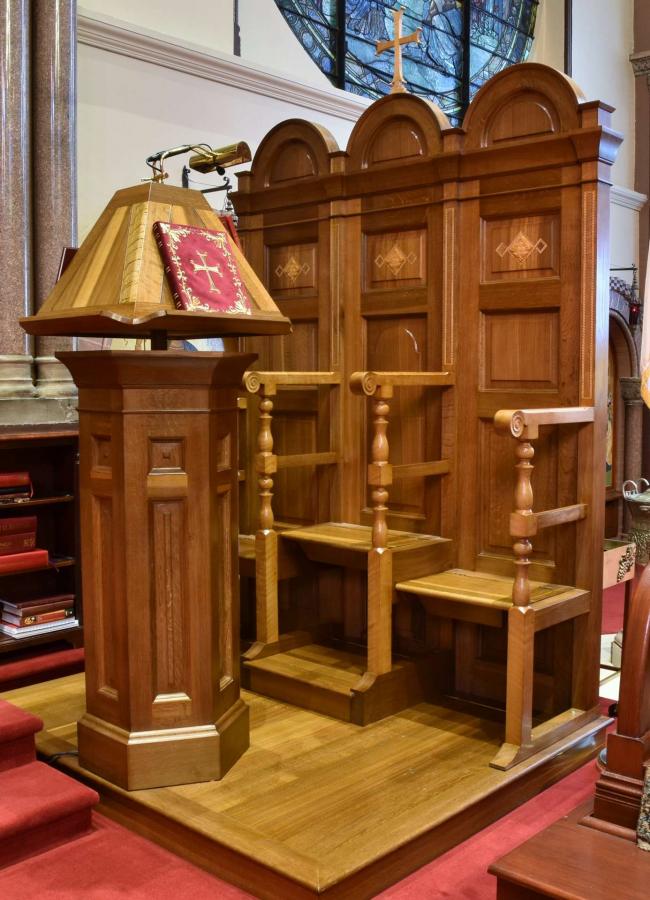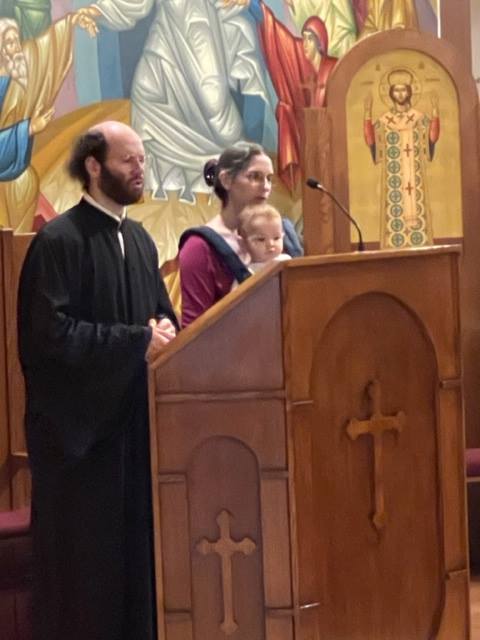
I am quite incapable of writing objectively about the chant stand, the analogion, that precarious collection of seats and a rotating music stand and piles of dusty books which forms the home for the chanters of the Greek church. For me the chant stand is simply the beating heart of the church, whose throbbing sound provides the lifeblood of the services: inescapable, absolutely necessary. But I have an unusual history.
I stood at the chant stand for years before I joined the Church. I was a graduate student studying theology, and after some discussion the seminary decided that it was permissible for a non-Orthodox Christian to take part in the chanting, as long as my voice by itself was never heard alone. Over the years this did produce some humorous moments; I particularly remember the feast during a vacation where I was at the chant stand with one other student who knew none of the music or texts for the day. In whispers I kept telling him to join in, to make some uninformed noise, to provide some sonic background as affirmation of the orthodoxy of my words.
I was aware of the hilarity of this situation, but even at the time I also respected the actual importance of this consideration (in contrast, I may say, to many members of the Church who heard about this and found it embarrassingly absurd). In the fourth century, the Church at the council in Laodicea laid down a stricture forbidding the use of "uninspired" hymns at the same time as they forbade the reading of uncanonical books, those not included in the Bible. "Uninspired" was a particularly good choice of word; the Church who tells of many of her hymnographers as divinely inspired, eating scrolls or whisked up to heaven and suddenly issuing forth new, eloquent hymns, can hardly define appropriate hymns as those which have received approval from some governing body or inclusion in some particular text. But the inability of humankind to harness the Spirit does not mean that every human whim is Spirit-filled, nor that every ecstatic utterance is, in fact, inspired. An Orthodox voice droning unintelligible attempts at words on hesitant notes while a non-Orthodox voice chants the hymns is a perfect example of the ridiculous situations we humans create in our attempts to balance institutional oversight with individual fluctuations, orthodoxy with orthopraxy, inspiration and tradition. The balance cannot be attained. Our attempts to attain to it are like our participation in an unpracticed dance—always dynamic, often undignified, and sometimes laughable—but it must be laughed at only tenderly and with love and respect. I call it a dance not to belittle it, but to recognize the lightness with which we must regard it. Like watching a child learn to walk, we see it with joy and a silent sense of wonder, fearful to put out a hand lest our efforts to help hinder this mysterious progression towards we know not what.
The dance of the liturgy is, for me, most easily seen at the chant stand. Long-practiced cantors communicate the whole service with the occasional raised eyebrow or flick of the finger. New cantors stumble over words they know perfectly well, come in too soon, flicker between near-whispers and overly loud shouts. Communication between the chant stand and the altar may be seamless, as though the iconostasis suddenly grew transparent; or both priest and cantor may stop in utter confusion and a sudden silence fall in the sanctuary while they peer at books or iPhones. A single service can run the full span of human emotions, from humble patience to sheer joy to total embarrassment to silent fury. And nowhere else in the church, I think, is the interplay between public and private practice so tangible.
Chanting the liturgy is not easy. Learning the musical system of chant, the thousands of hymns, the variety of languages and translations preferred by the whims of the clergy and the congregation, and the navigation of the books and constantly-changing websites is a discipline which takes a lifetime. Chanting with the ever-changing and deeply individual company of chanters at the chant stand requires an entirely different and equally important set of skills. But the hours and energy poured into these pursuits are the silent, invisible underpinnings of the liturgical dance. It is not easy to tell whether a cantor has spent hours preparing for a service or not. Preparation does not eliminate mistakes or confusion. But for the cantor, the lonely practice and the public liturgy are inextricably intertwined, tugging at each other and refusing to let go. My teacher once chided me for letting perfectionism get the better of me at the chant stand, thrown off by my own mistakes. Perfectionism, he told me, is only for the hours of practice. Entering the church, you have done what you have done. Let all worries go and merely chant, knowing that all human endeavor is fraught with error.
Navigating these tricky waters within my own practice emphasizes the enormous amount I do not know about my fellow congregants. My private preparation is visible to me—both chanting, formal prayer, and all the actions of my life which harm or build up my soul for the liturgy—but is unknowable to others. Thus their participation in the liturgy, their public participation in our dance, is likewise the tip of a great unseen iceberg. We come together as friends and siblings but still always as strangers, separated by our ignorance. Love and respect for their dance—above all, the unseen and silent parts of their dance—covers this separation silently, binding us together in God’s ineffable union.

Sarah Roumas received a bachelor’s degree in physics from Harvard University, a master of theological studies and a master of theology degree from Holy Cross Greek Orthodox School of Theology in Brookline, Massachusetts, and a Ph.D in liturgical theology from the University of Notre Dame. She studies the development of the Byzantine liturgical books and biblical interpretation in Byzantine hymns. Her dissertation was on the hymns of Lazarus Saturday in Greek manuscripts of the Triodion. She is currently a postdoctoral fellow at the University of Notre Dame in South Bend, Indiana, where she chants at St. Andrew’s Greek Orthodox Church and lives with her husband Nicholas and baby son, Anthony.


